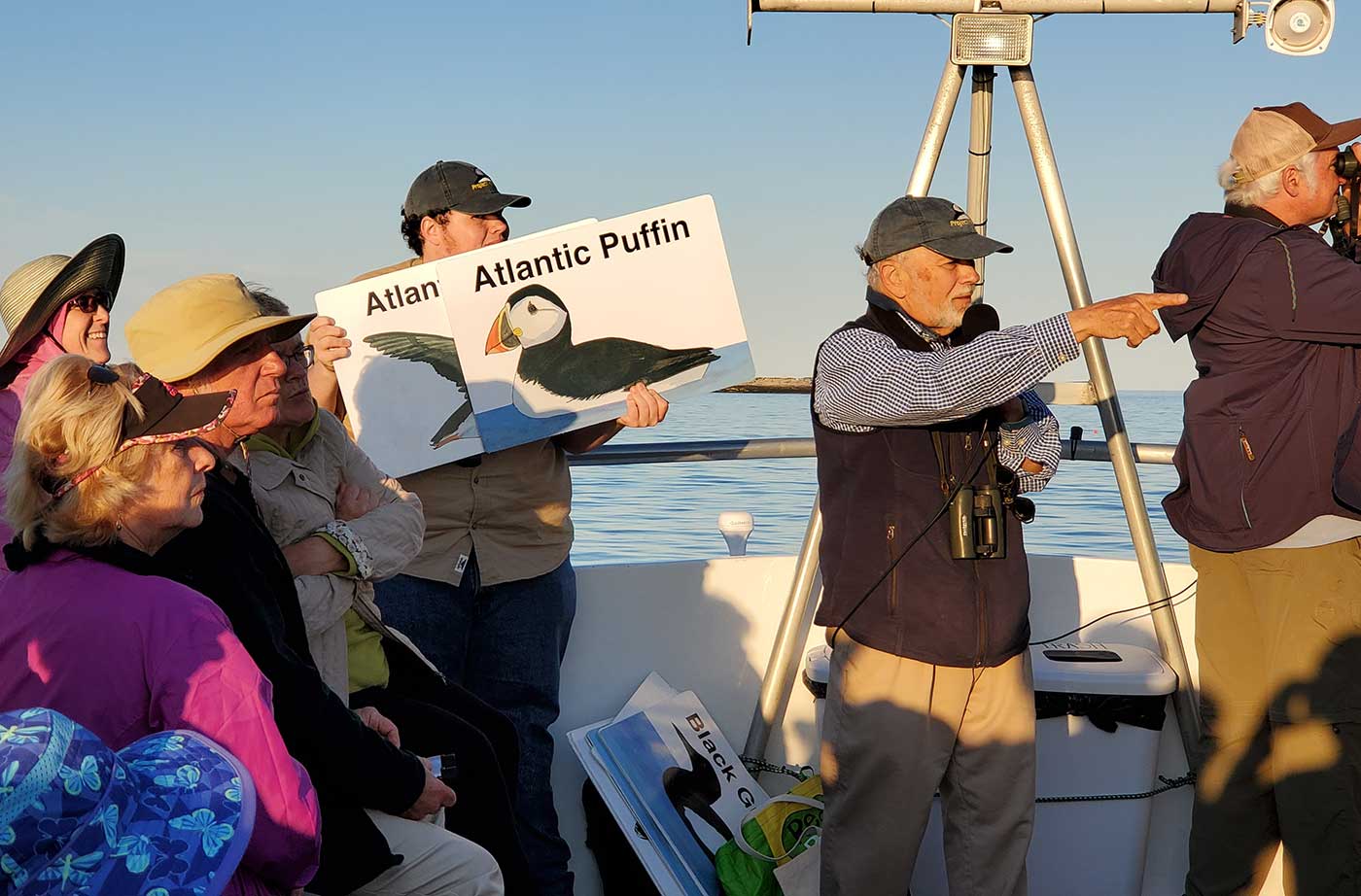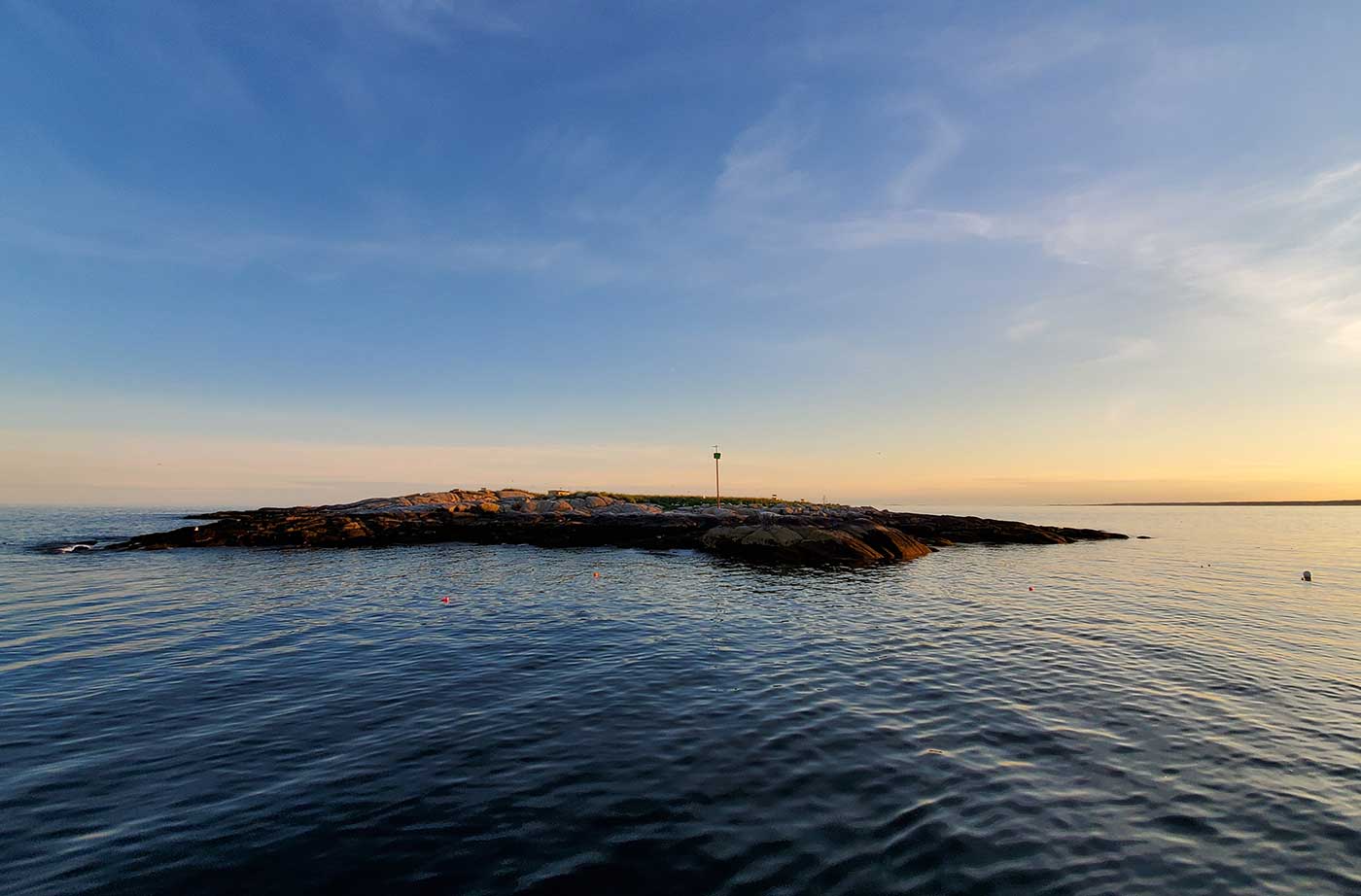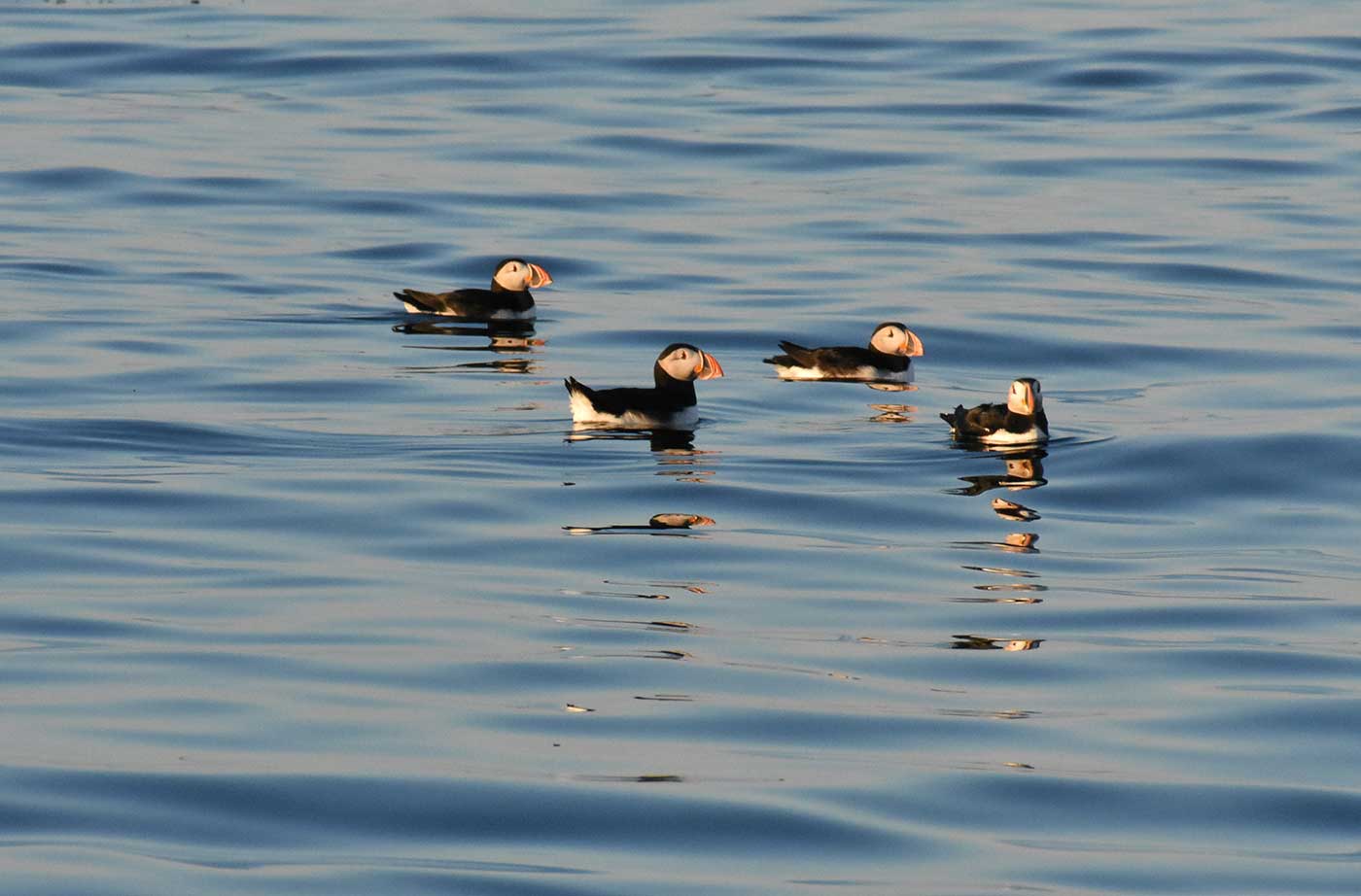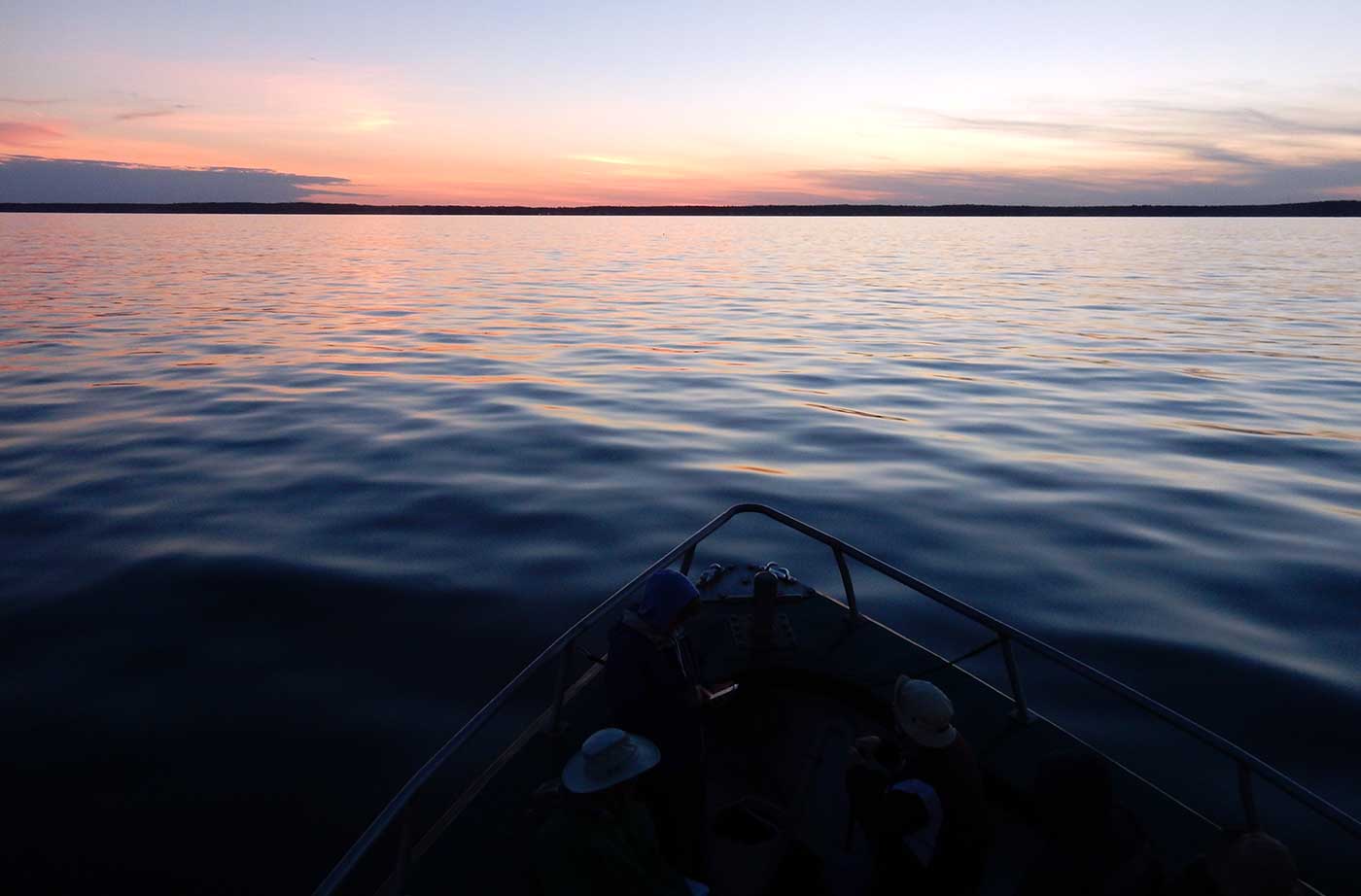On Thursday, July 18, we were transported to another world.
The world of puffins.
We, along with more than 100 members of the Natural Resources Council of Maine (NRCM), boarded the Hardy Boat in New Harbor on a warm, calm summer evening along the coast of Maine. We were thrilled to be joined by Dr. Stephen Kress, a good friend of ours going back to our years at Cornell. As founder of Project Puffin, no one knows more about Maine’s most famous summer residents than he does, and the group was eager to his insider knowledge.

Dr. Steve Kress (photo by L. Hahn/NRCM)
The group settled into their seats, Steve took his place at the front of the boat, microphone in hand, and as we pulled away from the dock at 7 pm, we immediately began creating another fantastic puffin watch memory.
Our destination was the famed Eastern Egg Rock, a tiny island about 900 feet long and 500 feet wide, located 5 miles off shore from New Harbor and the Pemaquid Peninsula. That tiny island (and its sister island of Western Egg Rock) were so named because hundreds of years ago the early fishermen and European settlers harvested eggs from the colonies of seabirds that nested on them. From the mid-1800s into the early 1900s, large numbers of adult seabirds were also slaughtered relentlessly on these and other Maine islands for their feathers and for food.
As a result of this heavy exploitation, the colony of Atlantic Puffins that had nested on Eastern Egg Rock disappeared from the island by the late 1800s. By the 1930s, the terns that had also nested here for millennia left the island, under duress of the merciless killing.

Eastern Egg Rock in Muscongus Bay (photo by L. Hahn/NRCM)
Luckily for all of us, a very optimistic young National Audubon scientist named Steve Kress arrived in Maine in the 1970s. Steve learned about the past history of Eastern Egg Rock and wondered whether it would be possible to return the island to the thriving seabird colony it had once been—including a home for Atlantic Puffins.
Fortunately, Steve didn’t listen to the naysayers who told him it was impossible or too difficult or too costly. He forged ahead and found a way to transport tiny puffin chicks from Newfoundland to Eastern Egg Rock. He and his assistants placed the chicks in artificial burrows of a sort, and with sheer dedication fed them for weeks. When the chicks were old enough to take care of themselves, the birds left for the sea. Steve and his team kept this up for years, eventually transporting and rearing almost a thousand puffin chicks. They watched and waited during those years until finally in 1981 five pairs of puffins came back to nest. Eastern Egg Rock was the host of a puffin colony again after a 100-year absence.

Atlantic Puffins (photo by B. Comeau/NRCM)
The island now supports more than 150 pairs of nesting Atlantic Puffins. As Captain Al Crocetti carefully and expertly ferried us closer to the island aboard the Hardy Boat, the puffins seemed to greet us, popping up from the ocean depths right near the boat, bobbing in flocks of several dozen or more, zipping by us with a bill full of food for their young nestled in burrows among the rocks. Everyone aboard was delighted by the puffin display, and by the cacophony coming from Black Guillemots, Laughing Gulls, Common Terns, and other species. Among the highlights for the serious birders among us: A Razorbill flying back and forth along the island before finally taking a seat in plain view among a couple dozen Black Guillemots resting on a rocky ledge, and an Arctic Tern zipping by among the Common and Roseate Terns (a nice find for our “mindfulness birding Big Year”).
The puffins, though, were a heartening reminder of what can be accomplished in the face of obstacles. Maine’s environment and wildlife faced many obstacles over the past eight years. NRCM Advocacy Director Pete Didisheim’s summary of this year’s legislative session as we pulled out of New Harbor listed victory after victory for Maine’s air, land, waters, and wildlife. These include long-overdue updates to our state’s energy policies that will benefit puffins and other animals while helping protect our seaside communities by tackling climate change.
During the cruise back to New Harbor, the skies over Muscongus Bay put on an incredible light show as the sun slowly slipped below the horizon. The patter among NRCM members and staff continued—the word “magical” was used a lot. Even Steve Kress admitted that the puffins were extraordinarily cooperative that evening.

Sunset on Muscongus Bay (photo by A. Wells/NRCM)
We like to think it’s because the birds somehow know that NRCM and its members are actively engaged in work to take care of the environment they need to thrive.
If you are an NRCM member, thank you for your support. If you’re not, please consider becoming one. And while you’re at it, why not find out about actions you can take to protect Maine’s environment?
NRCM created a Facebook album of photos from this year’s puffin trip. Enjoy!











Beautiful birds , beautiful Maine & beautiful people! Thank you all so much for such an enlightening evening & thank you Stephen Kress for your dedication & hard work !
Hi, Ruth-
It was so wonderful to meet you, all the more so on the puffin cruise! We’re so glad you had such a great time. We did, too!
We hope you will come to Maine again soon!
A beautiful evening with such knowledgeable folks. Learned so much about puffins and the other sea birds that make their home on the island. Thank you for such a restful evening with ideal weather! We want to do it again.
Suzanne,
Thanks so much for joining us! We are already looking forward to next year’s!